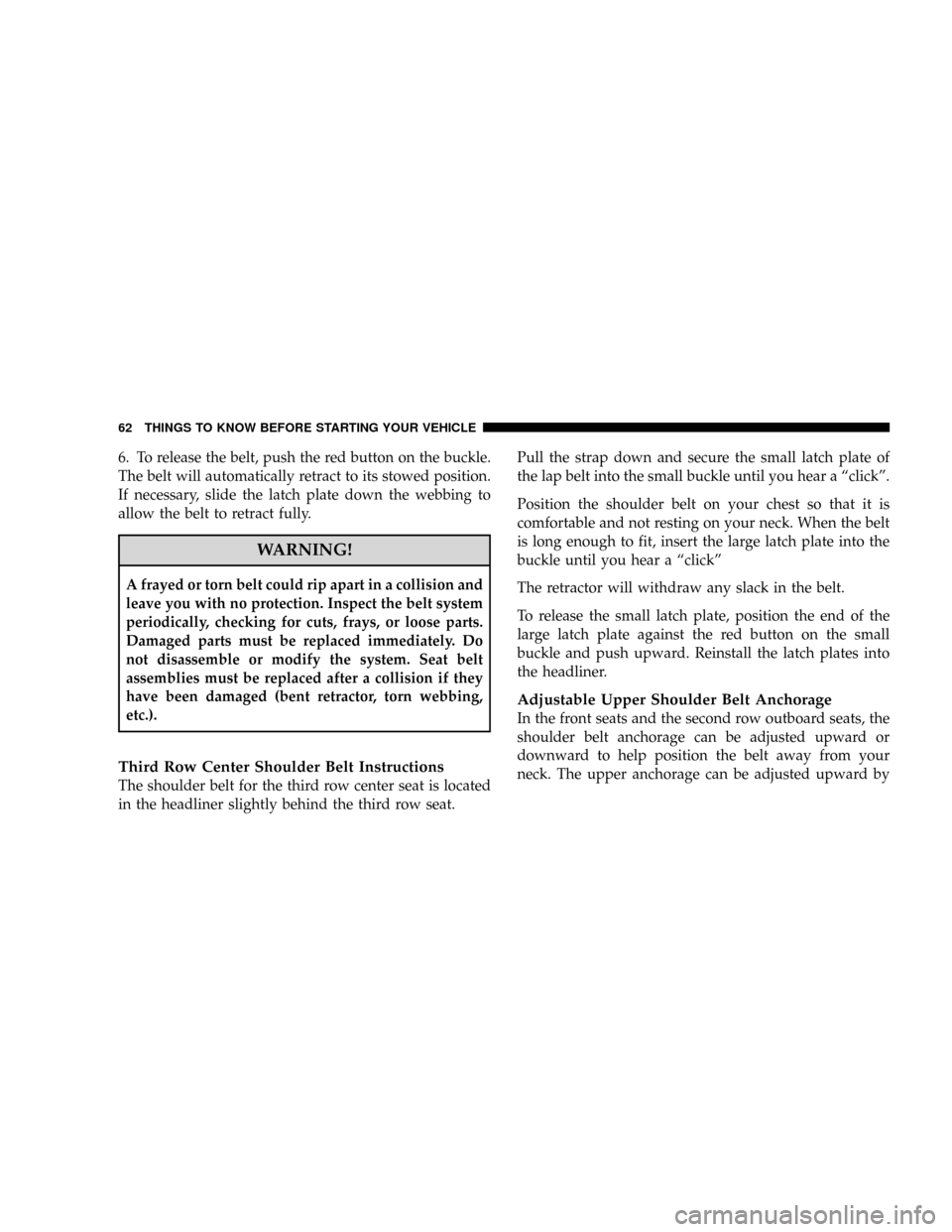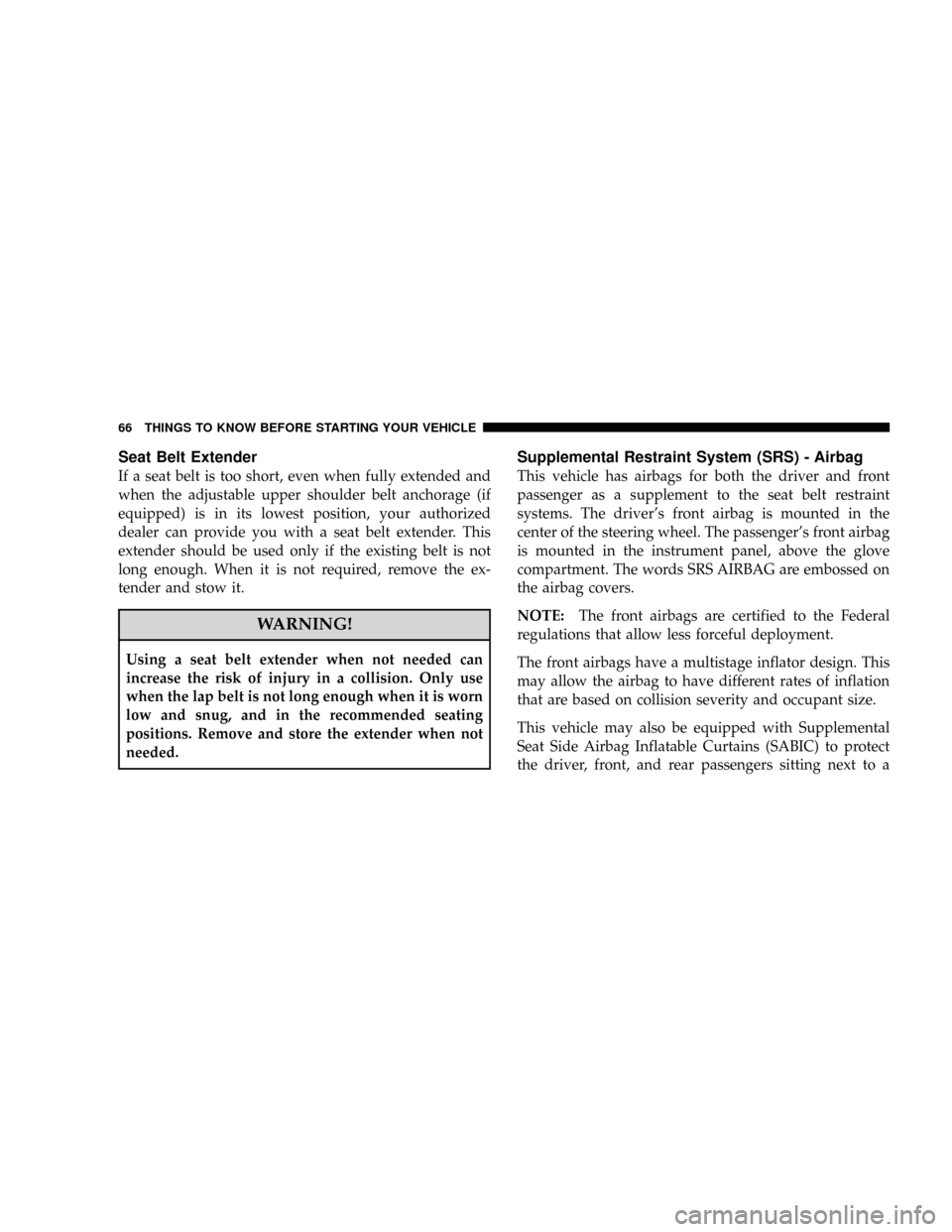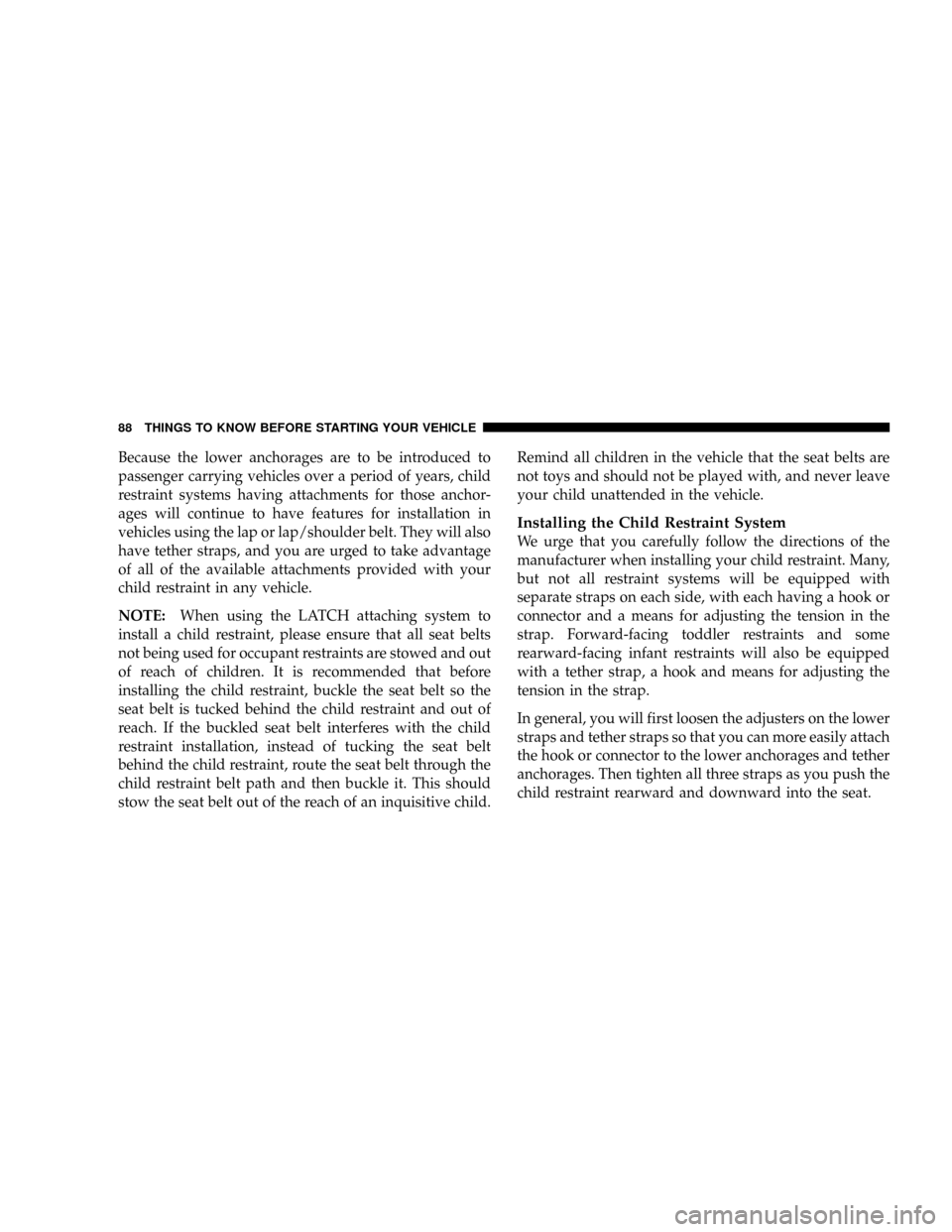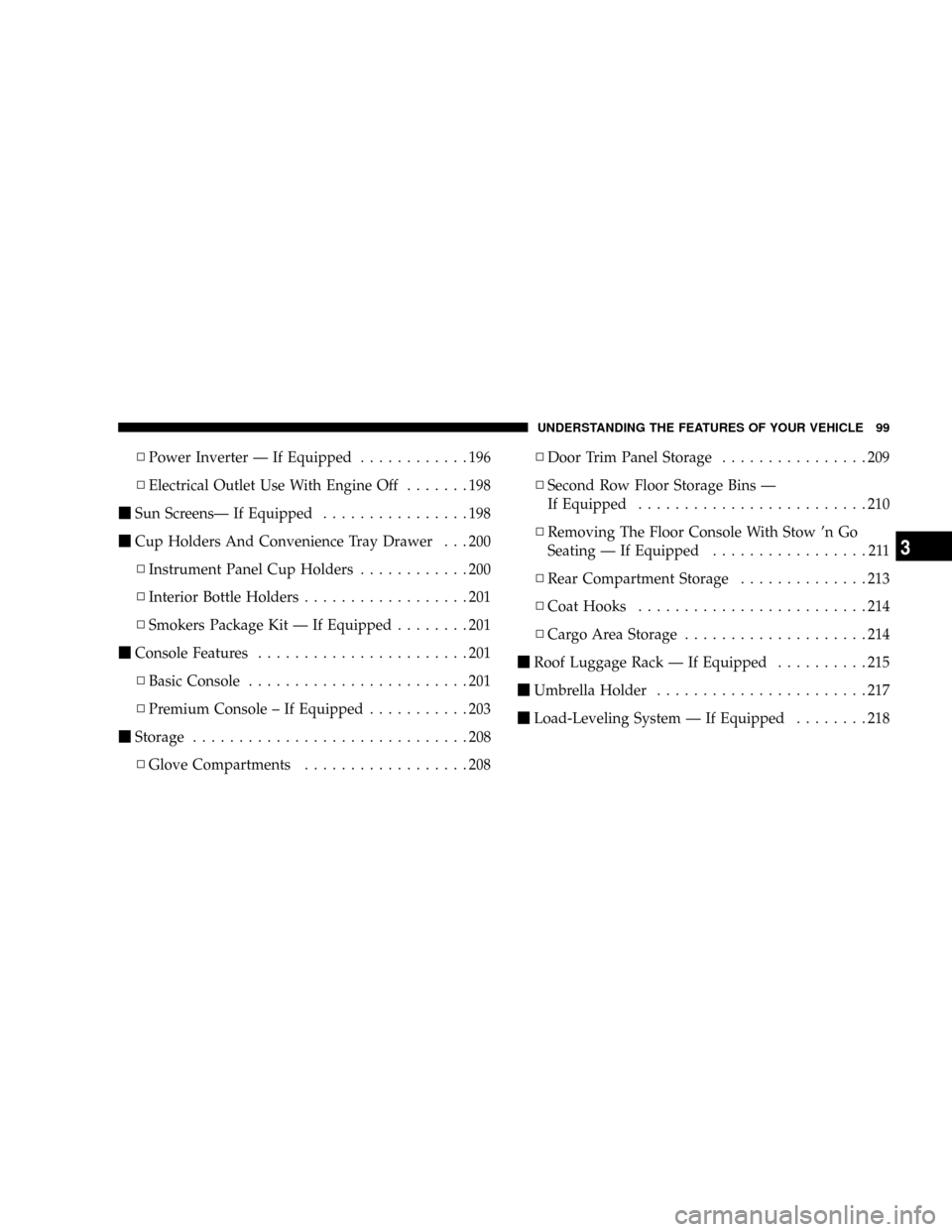Page 29 of 531
2. Remove and replace the battery. Avoid touching the
new battery with your fingers. Skin oils may cause
battery deterioration. If you touch the battery, clean it
with rubbing alcohol.
3. Reposition the access door panel over the battery
opening and snap into place.
General Information
This device complies with part 15 of the FCC rules and
RSS 210 of Industry Canada. Operation is subject to the
following conditions:
²This device may not cause harmful interference.
²This device must accept any interference received,
including interference that may cause undesired op-
eration.
If your RKE transmitter fails to operate from a normal
distance, check for these two conditions.
1. A weak battery in the RKE transmitter. The expected
life of the battery is a minimum of three years.
2. Closeness to a radio transmitter such as a radio station
tower, airport transmitter, and some mobile or CB radios.
Battery Replacement
THINGS TO KNOW BEFORE STARTING YOUR VEHICLE 27
2
Page 48 of 531
Sliding Side Door Child Protection Lock
To provide a safer environment for small children riding
in the rear seats, the sliding doors are equipped with a
child protection door lock system.
NOTE:When the child lock system is engaged, the door
can be opened only by using the outside door handle
even though the inside door lock is in the unlocked
position.
To Engage The Child Protection Door Lock
1. Open the sliding side door.2. Slide the child lock control inward (toward the ve-
hicle) to engage the Child Protection Door Lock.
3. Repeat Steps 1 and 2 on the opposite sliding door.
Child Protection Door Lock
46 THINGS TO KNOW BEFORE STARTING YOUR VEHICLE
Page 64 of 531

6. To release the belt, push the red button on the buckle.
The belt will automatically retract to its stowed position.
If necessary, slide the latch plate down the webbing to
allow the belt to retract fully.
WARNING!
A frayed or torn belt could rip apart in a collision and
leave you with no protection. Inspect the belt system
periodically, checking for cuts, frays, or loose parts.
Damaged parts must be replaced immediately. Do
not disassemble or modify the system. Seat belt
assemblies must be replaced after a collision if they
have been damaged (bent retractor, torn webbing,
etc.).
Third Row Center Shoulder Belt Instructions
The shoulder belt for the third row center seat is located
in the headliner slightly behind the third row seat.Pull the strap down and secure the small latch plate of
the lap belt into the small buckle until you hear a ªclickº.
Position the shoulder belt on your chest so that it is
comfortable and not resting on your neck. When the belt
is long enough to fit, insert the large latch plate into the
buckle until you hear a ªclickº
The retractor will withdraw any slack in the belt.
To release the small latch plate, position the end of the
large latch plate against the red button on the small
buckle and push upward. Reinstall the latch plates into
the headliner.
Adjustable Upper Shoulder Belt Anchorage
In the front seats and the second row outboard seats, the
shoulder belt anchorage can be adjusted upward or
downward to help position the belt away from your
neck. The upper anchorage can be adjusted upward by
62 THINGS TO KNOW BEFORE STARTING YOUR VEHICLE
Page 68 of 531

Seat Belt Extender
If a seat belt is too short, even when fully extended and
when the adjustable upper shoulder belt anchorage (if
equipped) is in its lowest position, your authorized
dealer can provide you with a seat belt extender. This
extender should be used only if the existing belt is not
long enough. When it is not required, remove the ex-
tender and stow it.
WARNING!
Using a seat belt extender when not needed can
increase the risk of injury in a collision. Only use
when the lap belt is not long enough when it is worn
low and snug, and in the recommended seating
positions. Remove and store the extender when not
needed.
Supplemental Restraint System (SRS) - Airbag
This vehicle has airbags for both the driver and front
passenger as a supplement to the seat belt restraint
systems. The driver's front airbag is mounted in the
center of the steering wheel. The passenger's front airbag
is mounted in the instrument panel, above the glove
compartment. The words SRS AIRBAG are embossed on
the airbag covers.
NOTE:The front airbags are certified to the Federal
regulations that allow less forceful deployment.
The front airbags have a multistage inflator design. This
may allow the airbag to have different rates of inflation
that are based on collision severity and occupant size.
This vehicle may also be equipped with Supplemental
Seat Side Airbag Inflatable Curtains (SABIC) to protect
the driver, front, and rear passengers sitting next to a
66 THINGS TO KNOW BEFORE STARTING YOUR VEHICLE
Page 90 of 531

Because the lower anchorages are to be introduced to
passenger carrying vehicles over a period of years, child
restraint systems having attachments for those anchor-
ages will continue to have features for installation in
vehicles using the lap or lap/shoulder belt. They will also
have tether straps, and you are urged to take advantage
of all of the available attachments provided with your
child restraint in any vehicle.
NOTE:When using the LATCH attaching system to
install a child restraint, please ensure that all seat belts
not being used for occupant restraints are stowed and out
of reach of children. It is recommended that before
installing the child restraint, buckle the seat belt so the
seat belt is tucked behind the child restraint and out of
reach. If the buckled seat belt interferes with the child
restraint installation, instead of tucking the seat belt
behind the child restraint, route the seat belt through the
child restraint belt path and then buckle it. This should
stow the seat belt out of the reach of an inquisitive child.Remind all children in the vehicle that the seat belts are
not toys and should not be played with, and never leave
your child unattended in the vehicle.
Installing the Child Restraint System
We urge that you carefully follow the directions of the
manufacturer when installing your child restraint. Many,
but not all restraint systems will be equipped with
separate straps on each side, with each having a hook or
connector and a means for adjusting the tension in the
strap. Forward-facing toddler restraints and some
rearward-facing infant restraints will also be equipped
with a tether strap, a hook and means for adjusting the
tension in the strap.
In general, you will first loosen the adjusters on the lower
straps and tether straps so that you can more easily attach
the hook or connector to the lower anchorages and tether
anchorages. Then tighten all three straps as you push the
child restraint rearward and downward into the seat.
88 THINGS TO KNOW BEFORE STARTING YOUR VEHICLE
Page 99 of 531
UNDERSTANDING THE FEATURES OF YOUR VEHICLE
CONTENTS
mMirrors..............................100
NManual Rear View Day/Night Mirror Ð
If Equipped.........................100
NExterior Mirrors......................102
mHands-Free Communication (UConnectt)Ð
If Equipped...........................104
NOperation...........................106
NPhone Call Features...................113
NUConnecttSystem Features..............116
NAdvanced Phone Connectivity............120NThings You Should Know About Your
UConnecttSystem....................122
NGeneral Information...................131
mSeats................................131
NManual Front And Second Row Seat
Adjuster............................132
NStow 'n Go Seating Ð If Equipped.........138
NSwivel 'n Go Premium Seating Ð
If Equipped.........................148
mDriver Memory Seat Ð If Equipped.........155
3
Page 101 of 531

NPower Inverter Ð If Equipped............196
NElectrical Outlet Use With Engine Off.......198
mSun ScreensÐ If Equipped................198
mCup Holders And Convenience Tray Drawer . . . 200
NInstrument Panel Cup Holders............200
NInterior Bottle Holders..................201
NSmokers Package Kit Ð If Equipped........201
mConsole Features.......................201
NBasic Console........................201
NPremium Console ± If Equipped...........203
mStorage..............................208
NGlove Compartments..................208NDoor Trim Panel Storage................209
NSecond Row Floor Storage Bins Ð
If Equipped.........................210
NRemoving The Floor Console With Stow 'n Go
Seating Ð If Equipped.................211
NRear Compartment Storage..............213
NCoat Hooks.........................214
NCargo Area Storage....................214
mRoof Luggage Rack Ð If Equipped..........215
mUmbrella Holder.......................217
mLoad-Leveling System Ð If Equipped........218
UNDERSTANDING THE FEATURES OF YOUR VEHICLE 99
3
Page 102 of 531
MIRRORS
Manual Rear View Day/Night Mirror Ð If Equipped
Adjust the mirror to center on the view through the rear
window. A two point pivot system allows for horizontal
and vertical adjustment of the mirror.Annoying headlight glare can be reduced by moving the
small control under the mirror to the night position
(toward rear of vehicle). The mirror should be adjusted
while set in the day position (toward windshield).
Automatic Rear View Day/Night Mirror Ð If
Equipped
When using this feature the mirror will automatically
adjust for annoying headlight glare from vehicles behind
you. You can turn the feature on or off by pressing the
button at the base of the mirror. A power indicator light
to the side on/off button will indicate when the dimming
feature is activated.
Manual Rearview Mirror
100 UNDERSTANDING THE FEATURES OF YOUR VEHICLE